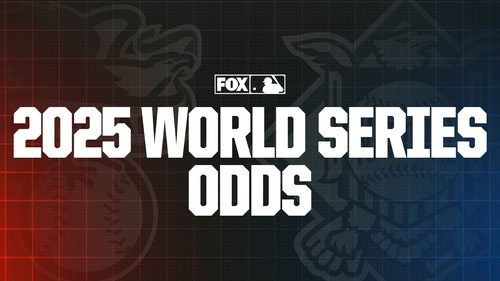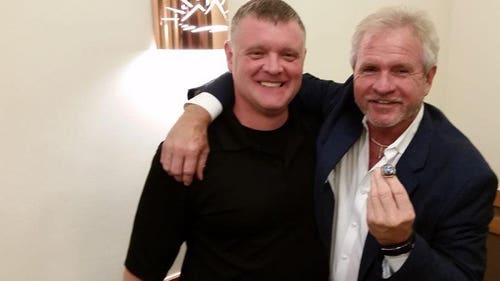
Noah Syndergaard and Justin Verlander: What to expect in their return from Tommy John surgery
By Jordan Shusterman
FOX Sports MLB Writer
Noah Syndergaard and Justin Verlander just got paid. Syndergaard left the Mets for the Angels on a one-year deal worth $21 million. Verlander re-signed with the Astros for $25 million.
When they make their first starts for their respective teams in 2022, perhaps on Opening Day, it will have been nearly 30 months since each last threw a meaningful pitch. And with their signings occurring so close together last week, it was hard not to see them as linked.
So I wanted to know: When an established starting pitcher enters spring training 100 percent back from Tommy John surgery but having barely or not yet returned to action, what can we expect from him that season?
I’m most interested in this question from a workload standpoint, since a common reaction to the Verlander and Syndergaard signings was: "That’s a lot of money for 120 innings!" I’ll admit, I thought the same thing, so I wanted to find out how many innings pitchers have thrown in their first seasons back after surgery.
Thanks to the excellent work of Jon Roegele, there is a tremendously thorough and organized public database of pitchers who have had Tommy John surgery and the timelines associated with their return to the mound. Using this resource, we can narrow the large list to those who had TJ and returned under similar circumstances as Syndergaard and Verlander.
What are those circumstances exactly? The pitchers needed to meet the following criteria:
— Had already been established as a big-league starting pitcher.
— Made their official MLB return from Tommy John surgery either briefly in September of the season before (à la Syndergaard) or at the start of a season (à la Verlander, assuming he stays on schedule).
(Here I will note that these circumstances also apply to three pitchers who could play big roles in the 2022 postseason race: Luis Severino, Dakota Hudson and Mike Clevinger. Thus, the following analysis can be kept in mind when projecting their performance next year as well. But let’s stay focused on the fancy free agents.)
This meant I would not be looking at pitching prospects who underwent TJ and returned to pitch in the minors. Nor would I be looking at pitchers who returned midseason (Dinelson Lamet in 2019, Nathan Eovaldi in 2018, Yu Darvish in 2016). Also, for the purposes of this exercise, I excluded pitchers who returned in 2020 because the shortened season did not allow for a "full season" return (Carlos Rodón, for example).
Those criteria left me with 27 names, from Jamie García to Jameson Taillon. On average, these starting pitchers made 21 starts and threw roughly 132 innings in their first full seasons coming off TJ. Only 14 of the 27 made at least 28 big-league starts, while just eight threw at least 175 innings: Lance Lynn, Jason Vargas, Alex Cobb, Matt Harvey, Drew Hutchison, John Lackey, Shaun Marcum and Jake Westbrook, who topped the list with 202.2 IPs in 2010.
Now that we have a sense for how much they pitched, how well did they pitch? Considering the sample size and the huge variance in talent, I don’t think it’s instructive to compare Syndergaard and Verlander to the likes of Hutchison or Josh Tomlin. But the top end of these performances includes Harvey in 2015, Stephen Strasburg in 2012 and the tremendous Kris Medlen campaign in 2012 (1.57 ERA in 138 IPs).
I focused strictly on that first season back from surgery, not what happened in the pitchers’ careers in the years following. Such a distinction is especially important when analyzing the likes of Harvey and another former Met: Zack Wheeler.
Harvey was excellent in his first year back (2.71 ERA in 189.1 IPs in 2015) before quickly declining in the years following. Wheeler, meanwhile, represents more of a cautionary tale for someone such as Syndergaard, as he dealt with myriad ups and downs both health- and performance-wise in 2017, his first year back. Wheeler didn’t become the Cy Young candidate he is today until several seasons later.
For the Los Angeles Angels, all that matters is the first year. The clock is ticking on getting Mike Trout and Shohei Ohtani to the postseason, so Syndergaard has to deliver immediately.
Another helpful parallel for Syndergaard is the most recent TJ comeback story: Taillon. Entering 2021, Taillon was coming off a second Tommy John, having undergone his first in 2014 while in the minors. But he was the exact same age as Syndergaard and held a similarly high-prospect pedigree before surgery. Taillon had some non-arm-related injury hiccups in 2021, but he was otherwise healthy and made 29 starts for the New York Yankees.
Like Syndergaard, Taillon moved from the National League to the American League, and his numbers from his pre-surgery form of 2018 took a slight hit, making him roughly an average starting pitcher over his 144.1 IPs, with flashes of excellence mixed in. Three other pitchers in the sample of similar ages to Syndergaard also looked good-not-great in their return seasons relative to their pre-surgery form: Michael Pineda, Lynn and Cobb.
Both Syndergaard and Verlander just signed for a truckload of U.S. dollars. Both were good pitchers before surgery, and both are known for throwing very hard. Both will be pitching in the AL West in 2022, and they very well could face off multiple times during the year. (Houston visits Anaheim for four games from April 7-10, in case you were wondering.)
It’s also important to note the differences between Syndergaard and Verlander. For one, at almost 39, Verlander is nearly a decade older. For reference, remember that hilarious yearbook picture of Syndergaard from his freshman year of high school?
When that photo of Syndergaard was taken, Verlander had just won the 2006 American League Rookie of the Year. So yeah, there’s an age gap.
There’s also a talent gap — or at least, there was the last time we saw them. In 2019, Verlander won the AL Cy Young, while Syndergaard posted his worst season in the big leagues. Not that Thor was actually bad, but he didn’t look like the perennial ace he appeared to be developing into during his first couple of seasons.
What Syndergaard was doing in 2019, however, was throwing the baseball really, really hard. It would be easy to lump Syndergaard and Verlander together as Big Dudes Who Throw Hard, but they are clearly two different tiers of fireballer.
Pre-surgery, Syndergaard was the hardest-throwing starting pitcher in baseball. His four-seam fastball averaged 97.8 mph. For contrast, Verlander threw 59 pitches that hard in 2017, only 23 in 2018 and just seven in 2019. We know Verlander can still reach back and throw a fastball by hitters when he needs to, but he isn't on the same level as Syndergaard and hasn’t been for a long time.
The only recent precedent of a starting pitcher throwing anywhere close to as hard as Syndergaard before TJ was Strasburg, whose four-seamer averaged 97.3 mph before his infamous shutdown and surgery in 2011. Since returning, Strasburg has had plenty of success, but his fastball has never again topped 96 mph on average. The next closest example is another familiar name: Harvey, who averaged 95.8 mph on his heater before surgery and 95.9 mph in his first year back before the velo fell off precipitously in the years following.
In our brief glimpse of Syndergaard at the end of 2021, he threw 26 pitches in two games. His fastball averaged 94.2 mph and maxed at 96.2 mph, and he didn’t throw a single slider, which he used to throw 15% to 20% of the time (it was arguably his most effective pitch). We’ll give Thor the benefit of the doubt and assume that he wanted to just get back on a big-league mound and shake off the rust, rather than airing it out in those September outings.
The Angels will have to hope that was the case because Syndergaard might have to make some adjustments if his heater is now more mid-90s than high-90s. Regaining his elite velocity will likely be Syndergaard’s biggest challenge on the comeback trail.
The biggest challenge Verlander faces is his age. Of the more than 2,000 documented Tommy John surgeries over the past several decades, very few pitchers had the procedure at an older age than Verlander, and nearly all of them were relievers. The only examples of starting pitchers as old or older than Verlander to get Tommy John were Bronson Arroyo (who was 37) and Jamie Moyer (who was 47!).
They were at the end of their careers, looking for one final comeback. Both were throwing low-80s before and after surgery — and both were absolutely destroyed in their return seasons. With all due respect to Arroyo and Moyer, it’s unfair to compare Verlander to them.
As for the shortlist of relievers, it’s not a promising return. John Franco (41) and Arthur Rhodes (37) both came back from TJ to have a respectable season or two, but the other four — Joe Nathan (40), Jose Contreras (40), Rafael Betancourt (38) and Mike Fetters (38) — made only a handful of outings, most of which went very poorly.
Time is clearly not on Verlander’s side, but again, we’re talking about Justin Verlander. Still, we have to understand that what he is attempting — and the expectations on him to succeed in doing so — is completely unprecedented. Verlander said before his 2019 Cy Young campaign that he wants to pitch until he’s 45. It’s possible that having surgery has altered his ambitions somewhat, but if he comes back looking anywhere close to his 2019 form in 2022, he could absolutely pitch into his 40s.
There’s certainly far more pressure on Syndergaard. It’s no secret how top-heavy the Angels’ payroll is, and his addition only exacerbates that problem. We know they’ll be using a six-man rotation to accommodate Ohtani anyway, so that’s one way Syndergaard’s innings can be managed. It’s a bit unclear what the team expects his workload to be — there were some mixed messages following his signing:
It’s not just about his workload, though. How Anaheim chooses to optimize his arsenal will also have a huge impact on his success. All that said, if he delivers on his potential for even 140 innings, that’s great — but still probably not enough to push the Angels into the playoff picture.
Houston, meanwhile, remains the class of the AL West and boasts far greater pitching depth. Verlander's return is a huge deal, but it’s closer to a luxury than the desperate swing for high-end pitching that is the Angels’ signing of Syndergaard.
Overall, I’m more confident in Verlander’s ability to deliver on his big payday than Syndergaard's, and it seems like the market reflected that, considering he got the additional year of guaranteed money in the form of a player option. I think it will help Verlander to be where he’s already comfortable, and based on early reporting, it sounds like his stuff is likely to resemble that of his old self, more so than with Syndergaard.
As it stands now, it’s difficult to know for sure when, or if, Syndergaard’s pure stuff — once some of the best in the league — will be fully operational in 2022. Either way, both of these signings come with ample pros and cons and have set a high standard for the pitching market for the remainder of the winter.
Jordan Shusterman is half of @CespedesBBQ and a baseball analyst for FOX Sports. He lives in D.C. but is a huge Seattle Mariners fan and loves watching the KBO, which means he doesn't get a lot of sleep. You can follow him on Twitter @j_shusterman_.










